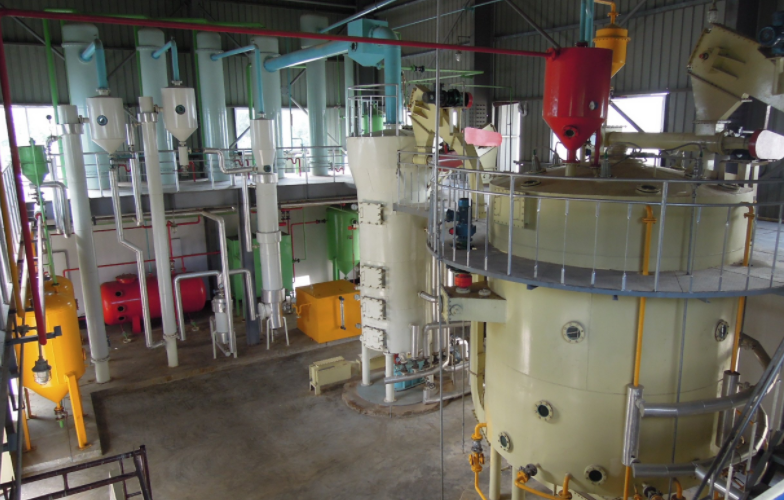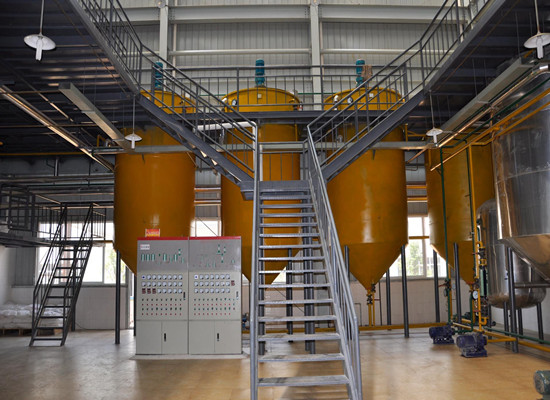Peanuts are high-oil-bearing oils, and edible oil can be extracted. Peanut oil extracted from peanut kernels is transparent, light yellow, and fragrant. Peanut oil is composed of 20% saturated fatty acids and 80% unsaturated fatty acids. The main ones are oleic acid, linoleic acid and palmitic acid. The iodine value is about 80-110. It is a dry oil. The oil is light yellow and transparent, and has a fragrance. It is an excellent cooking oil. The production process of peanut oil mainly includes the production process of pressed peanut oil, the production process of leaching peanut oil, and the production process of refined peanut oil. The following is an introduction to the production process of peanut oil.

1. Production process of pressed peanut oil
Peanut purchase → storage → screening → stone removal → classification → crushing → embryo rolling → steaming and frying → pressing → peanut crude oil → hydration and degumming → one filtration → two filtration → pressing peanut oil
(1) Magnetic separation
Use magnets to remove magnetic impurities in peanuts.
(2) Classification
Grading: Separate the big peanuts from the small peanuts, remove the large peanuts for frying seeds, and remove the small peanuts for squeezing.
(3) Screening
Using the difference in particle size and weight between peanuts and impurities, with the help of the relative movement of peanuts and impurities on the screen surface, a flat rotary sieve is used to remove large and small impurities and light impurities in peanuts.
(4) Broken
Use a crusher to crush the peanuts into 4 to 6 petals, so that they have the required particle size to meet the conditions of rolling embryos. The crushed peanuts are required to have uniform particle size, no oil, no agglomeration, and less powder.
(5) Rolling embryo
A single pair of roll blanking machine is used to roll the blanks and roll them into thin and uniform blanks. The billet is required to have a small powder degree, no oil leakage, and a thickness of 0.5 mm or less.
(6) Steam and stir-fry
Destroy the peanut cell structure, denature the protein, and swell the phospholipid by absorbing water to meet the requirements of extraction, speed up the oil output rate of the peanut oil extraction equipment, and reduce the phospholipid content.
(7) Squeeze
After the above pretreatment process, the peanuts can enter the peanut oil pressing equipment for pressing. The commonly used peanut oil pressing equipment is a screw press.
2. Production process of leaching peanut oil
In the production process of leaching peanut oil, a flat-rotation leaching device is used for leaching, using 6# solvent as the solvent. According to the quality and quantity of the blank, the leaching time (about 90min), the temperature is about 55℃, and the pressure is -0.01~-0.02. mmH, for leaching.

Production process of leaching peanut oil:
(1) One time evaporation
The mixed oil extracted from the flat-rotation extractor is composed of solvent, grease, and lipids accompanying the grease. The difference in boiling point between the grease and the solvent is used to heat the mixed oil to reach the boiling temperature, thereby vaporizing the solvent and the grease. Separate. The mixed oil first passes through the first evaporator to make the concentration reach 60% to 70%.
(2) Secondary evaporation
After the first evaporation, the mixture is evaporated through the second evaporator to accelerate the concentration to 90%-95%.
(3) Stripping
The residual solvent in the mixed oil is then completely removed by a stripping tower, and the stripping of the mixed oil is carried out under negative pressure (-0.03~0.04INHg).
3. Refined peanut oil production process
Peanut oil → degumming → deacidification → decolorization → deodorization → finished peanut oil

Production process of refined peanut oil:
(1) Coarse filtration
The leached peanut crude oil in the tank is filtered with a 120 mesh/inch crude oil coarse filter to remove residue.
(2) Heating up
After coarse filtration, the leached crude oil is heated to about 85 ℃ using a plate heat exchanger.
(3) Acid refining degumming
Adding 85% edible-grade phosphoric acid with a concentration of 0.05-0.1% of the oil can reasonably reduce the content of colloid and trace metals in peanut oil, and at the same time convert chlorophyll into light-colored pheophytin. The reaction time is approximately 25-30 minute.
(4) Alkali refining and deacidification
Use alkali to neutralize free fatty acids and make free fatty acids produce soapstock. Soap feet have a good adsorption effect and can adsorb a considerable amount of pigments, proteins, phospholipids and other impurities.
(5) The first centrifugal separation
The d centrifuge separates the oil from the soapstock, the oil enters the second centrifuge as the light phase, and the soapstock enters the soapstock tank as the heavy phase.
(6) The second centrifugal separation
The oil from the d centrifuge is added with soft water, and after mixing by the mixing pump, it enters the second centrifuge for oil-water separation, and the oil enters the drying process as the light phase.
(7) Dry
Dry the neutral oil under the conditions of a vacuum degree ≥ 0.08Mpa and a temperature of about 103°C for about 10 minutes.
(8) Decolorization
After adding the dried neutral oil to citric acid, the oil (110°C~115°C) that is heat exchanged by the primary heat exchanger enters the decolorization tower together, the decolorization vacuum degree is 0.09Mpa, and the reaction time is 30~45min.
(9) Filter
The oil/white clay mixture is pumped into the filter from the decolorization tower to be filtered, and the filtered oil enters the filtrate tank.
(10) Fine filtration
After filtering with a filter to remove the unfiltered impurities in the previous process, proceed to the next process.
(11) Deodorization
Using the difference in the volatility of odor substances and triglycerides in oils and fats, the odor substances are removed by steam distillation under high temperature and high vacuum conditions.
(12) Fine filtration
After being filtered by a filter, it is cooled by the effluent from the cooling water tower through a plate heat exchanger.
Copyright © Henan Zhongxing Grain And Oil Machinery Co.,Ltd. All Rights Reserved. Powered by MetInfo